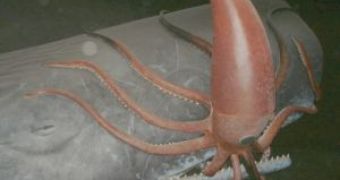The epic fights between sperm whales and giant squids witnessed by sailors fired the imagination of many biologists and nature lovers, with their mysterious cover.
And this especially because sperm whales are the largest predator in the world, 18 m (59 ft) long and 50 tons weight, with a huge appetite for squids, yet very little is known about their feeding behavior.
These whales are estimated to eat more than 220 billion pounds of squid yearly, equivalent to the entire harvest of all the commercial fisheries on Earth on a year, but nobody knows how the squid hunt really occurs.
Now, researchers had the opportunity to see how sperm whales search for the jumbo squid (Dosidicus gigas), an aggressive carnivore up to six feet (2 m) long and 100 pounds (45 kg) nicknamed "the red devil" because it attacks everything; it is found only in deep waters of western America, from Chile to Alaska.
They managed to tag electronically both species to peer at their habits up to thousands of feet underwater.
Squids were tagged by a team led by marine scientist William Gilly from Stanford University and the sperm whales by a team led by marine biologist Randall Davis of Texas A&M University in Galveston in the Gulf of California. "It's very rare to find a place like the Gulf of California where you can actually see sperm whales together with their prey," Davis said. "Adult sperm whales can stay underwater for more than an hour, but nobody knows exactly what they're doing down there," Davis said.
Even less is known about the behavior of jumbo squids. "It was only a couple of years ago that we discovered an area in the central Gulf of California where spawning and mating of these animals probably take place," Gilly said.
Davis's team employed a 25-foot carbon fiber pole to stick satellite-linked tags into the skin of five sperm whales, while Gilly's team tagged three jumbo squids at night. The tags, fitted under squid fins, detach themselves after two or three weeks and float to the surface and then emit stored data to satellites.
During the day, squids spent about 75 % of their time at depths of 600 - 1,300 ft (200 - 430 m), but at nighttime, more than 50 % of their time was spent above 600 feet (200 m), probably following their prey, like bioluminescent lanternfish, krill (a type of shrimp) and other crustaceans.
These prey species typically rise after dusk to feed on phytoplankton (photosynthetic small algae) and descend during the day to hide from tuna and other big fishes that employ light to detect them. But the whales spent 75 % of their time at 600 - 1,300 ft (200-430 m) day and night, "whether squid are there or not," Davis said. "Perhaps it's the only way they can catch them, but no one has ever seen a sperm whale feeding in the wild, so nobody really knows how they capture their food."
Curiously, squids often made rapid nighttime dives from the surface to depths where whales also go to. "Surface waters might stress the squid out perhaps due to the heat, which at up to 82 degrees Fahrenheit (27.7o C) is sweltering for squid, or due to the high oxygen content. We propose that jumbo squid are more susceptible to predation while they are recovering at depth immediately after a deep nighttime dive," Gilly said.
"Future research can tag more whales and squid and follow them around the year," Davis said. "There's much about these animals that remain a mystery."

 14 DAY TRIAL //
14 DAY TRIAL //